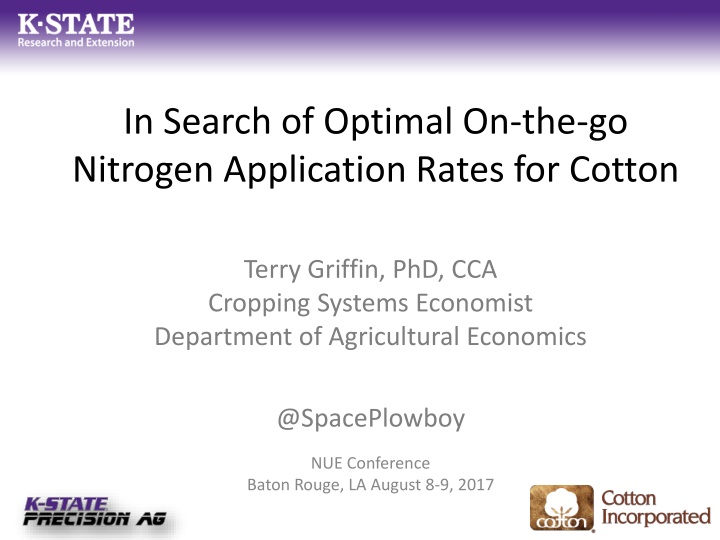
Optimal Nitrogen Application Rates for Cotton: On-the-go Strategies
Explore the quest for ideal nitrogen application rates for cotton through on-the-go techniques, as discussed by Terry Griffin, PhD, at the NUE Conference. Learn about the development of NDVI-based algorithms for automated controllers and the analysis of primary data across states for crafting efficient nitrogen application strategies in cotton cultivation.
Download Presentation

Please find below an Image/Link to download the presentation.
The content on the website is provided AS IS for your information and personal use only. It may not be sold, licensed, or shared on other websites without obtaining consent from the author. If you encounter any issues during the download, it is possible that the publisher has removed the file from their server.
You are allowed to download the files provided on this website for personal or commercial use, subject to the condition that they are used lawfully. All files are the property of their respective owners.
The content on the website is provided AS IS for your information and personal use only. It may not be sold, licensed, or shared on other websites without obtaining consent from the author.
E N D
Presentation Transcript
In Search of Optimal On-the-go Nitrogen Application Rates for Cotton Terry Griffin, PhD, CCA Cropping Systems Economist Department of Agricultural Economics @SpacePlowboy NUE Conference Baton Rouge, LA August 8-9, 2017
Lookup table v equation NDVI Nrec Ultimate goal: lookup table of N rec index to load into automated controller 0.00 0.05 0.10 0.15 0.20 0.25 0.30 0.35 0.40 0.45 0.50 0.55 0.60 0.65 0.70 0.75 0.80 0.85 0.90 0.95 1.00 10.6 16.1 20.9 24.9 28.2 30.7 32.4 33.5 33.7 33.2 32.0 30.0 27.2 23.7 19.4 14.4 8.6 2.1 0.0 0.0 0.0
Continuation of 2014 ASABE paper: Pooled Analysis of Combined Primary Data across Multiple States and Investigators for the Development of a NDVI- Based On-the-Go Nitrogen Application Algorithm for Cotton. Annual Meeting of the American Society of Agricultural and Biological Engineers. Paper No. 1900279 Terry Griffin, Barnes, E.M., Allen, P.A., Andrade-S nchez, P., Arnall, D.B., Balkcom, K., Barber, L.T., Bauer, P., Bronson, K.F., Buschermohle, M.J., Jones, A.P., Khalilian, A., Ge, Y., Roberson, G., Taylor. R.K., Tubana, B.S., Varco, J.J., Vellidis, G., Vories, E.D., Wilkerson, J.B., and Yin, X. 2014 ASABE and CSBE | SCGAB Annual International Meeting July 13 16, 2014, Montreal, Quebec Canada
Barnes, E.M., Allen, P.A., Andrade-S nchez, P., Arnall, D.B., Balkcom, K., Barber, L.T., Bauer, P., Bronson, K.F., Buschermohle, M.J., Jones, A.P., Khalilian, A., Ge, Y., Porter, W., Roberson, G., Taylor. R.K., Tubana, B.S., Varco, J.J., Vellidis, G., Vories, E.D., Wilkerson, J.B., Yin, X.
Sub-setting Primary Studies Identify well-behaved studies ?????? = ? + ?2
Dataframe construction Identifying Optimal Time Period ?????? = ? + ?2+ ???? + ? ??? ??? ?
Dataframe construction Identifying Optimal Time Period ?????? = ? + ?2+ ???? + ? ??? ??? ? Table 3. Select model diagnostics for NDVI timing analysis All Timings <= 6 WAP 6 to 8 WAP 8 to 10 WAP 10 to 12 WAP 12 to 14 WAP p-value on NDVI R-squared sample size 0.72 0.17 0.07 0.00 0.51 0.71 0.17 1978 0.48 192 0.19 428 0.22 498 0.37 331 0.51 262
Dataframe construction Duration of NDVI Measurements
Dataframe construction Pooled Database Construction Yield data were standardized by study Relative yield, relyld, by study Highest yield in field study = 1.0 Nitrogen rate normalized by study Relative to AONR ???? ???? 1 ???? = NDVI values remained same as primary studies Estimate maximum NDVI wrt N application ???? = ????~????
NDVI bounds for final dataframe Dataframe construction AONR (lbs/ac) NDVIref* 92 study soil year 2008 minNDVI NDVIAONR** 1 silt loam 0.75 0.36 0.75 9 loam 2008 71 0.66 0.28 0.64 12 sand 2010 92 0.57 0.17 0.52 14 sandy loam 2009 67 0.73 0.30 0.70 15 sandy loam 2010 85 0.82 0.57 0.81 16 sandy loam 2011 100 0.72 0.38 0.72 22 silt loam 2010 79 0.72 0.42 0.72 24 silt loam 2011 89 0.80 0.67 0.80 26 Silty clay loam 2008 97 0.54 0.14 0.54 * mean NDVI across highest N rate plots **expected NDVI at AONR estimated using ordinary least squares
Methods Random Effects Model The general specification of the random effects model: ? + (??+ ???) ???= ??? ? = 1, ,??,? = 1, ,? ? ??? ??~ ?,?? 2 and ???~ 0,?? 2 2 ?? ???= ??+ ??? ? ??? ???? ???,??? = 2+ ??2 ??? ??? ? ? ??
Analysis Algorithm Development Calculate nitrogen deficiency , Ndef ????? ??????for ??????<= ????? 0 for ??????> ????? ??????= Estimate relationship between Ndef and NDVI ???? = ???? + ????2
Regression Model Results Estimated coefficients (standard errors) OLS 39.01 (15.86) WLS 50.37 (16.62) REM 10.56 (16.87) Intercept 9.34 -11.79 (57.22) 118.16 (57.25) NDVI (54.70) -60.91 (44.84) -50.01 (46.72) -150.70 (48.52) NDVI^2
Future Work Revisit ETL procedure Include all 31 studies Not just well behaved Additional studies welcome Recombinant data Deviations from norm weather data Well-distributed precipitation e.g. Shannon s Apply additional pooled analysis methodologies
Terry Griffin twgriffin@ksu.edu 501.249.6360 @SpacePlowboy
